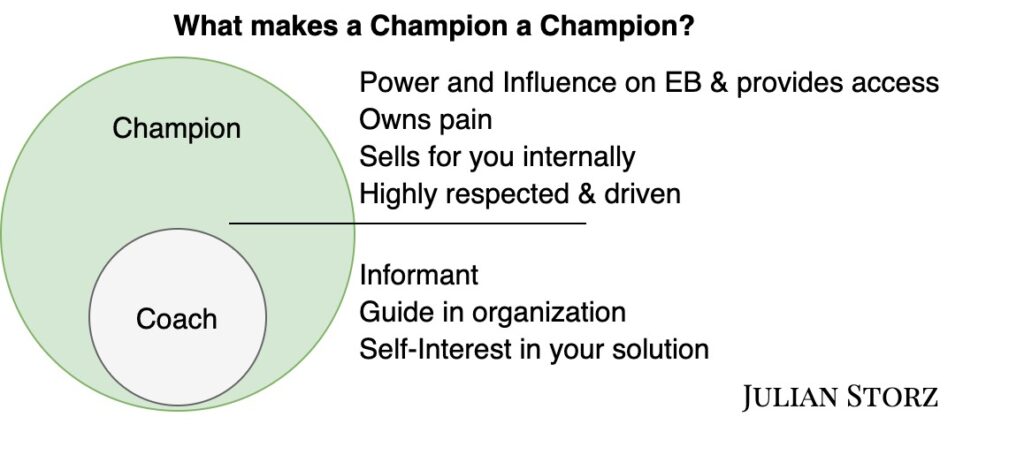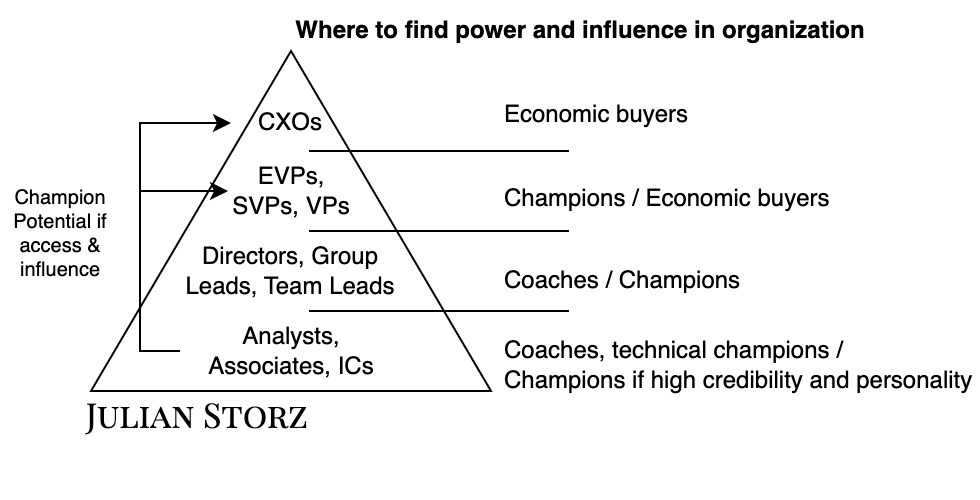In the world of sales, the MEDDICC framework emphasizes three critical components: Implicated Pain, the Champion, and the Economic Buyer. Among these, the Champion stands out as the central figure.
A strong champion is essential for driving the deal forward. They are the individuals who genuinely benefit from working with you and are invested in the success of the collaboration.
This article aims to provide a detailed perspective on the concept of a champion. If you are new to MEDDICC, you may want to start with the general overview available here: Deal Qualification in Sales – MEDDICC
Champion, Coach and Enemies
In the MEDDICC framework, understanding the roles of Enemies, Coaches, and Champions is crucial for a successful sales campaign. Each of these roles needs to be managed effectively.
While the difference between Champions and Enemies is usually clear, the distinction between Coaches and Champions can often be confusing. This confusion can result in deals falling through late in the sales cycle, risking the loss of many invested hours.
Therefore, it’s recommended to initially consider a person as a potential champion until they have been properly tested and proven their value.
Definition of an Enemy
An enemy in the MEDDICC framework is someone who opposes you or your solution. Often, they serve as the champion for an alternative product or vendor. Enemies can exhibit hostility, but they might also appear friendly while gathering information to advance their own agenda.
Because of this, it’s crucial to have a clear strategy to test potential champions and verify whether their support is genuine.
Definition of a Coach
A coach, in essence, is a subset of a champion. A coach acts as an informant, guiding you within the organization and showing interest in your success and the success of your solution.
Technical champions fall into this category, so it would be more accurate to refer to them as coaches rather than champions.
Definition of a Champion
A champion possesses all the characteristics of a coach: they act as an informant, guide you within the customer organization, and have a vested interest in your solution’s success. However, a champion goes beyond these roles.
A true champion owns the pain point and holds power and influence in the decision-making process. They either have the authority to make decisions themselves or can effectively influence the Economic Buyer (EB). They are also supportive in providing access to the EB when needed.
This influence on the Economic Buyer is especially crucial for sales that are unbudgeted, such as upgrades from a free open-source product or a free test subscription to a commercial offering. Since this money is typically not planned at the beginning of the budgeting cycle, support from higher levels is necessary to reallocate or shift the budget.

How to identify a Champion
Identifying a champion begins with a thorough understanding of your customer’s organization. There are two types of champions: those with decision-making authority and those who are influential change agents.
Authority-Based Champions:
- These champions can make decisions through their authority within the organization.
- Identify them by understanding the roles and responsibilities within the organization.
- Determine which levels hold decision-making power and what budget limits exist for each role.
Influence-Based Champions:
- Look for individuals who drive change and have high visibility within the organization.
- Identify people with a mandate to be change agents, often hired specifically to drive change in a particular area.
- Consider those with a high degree of network centrality due to their knowledge and credibility.
By focusing on these two types of champions, you can better navigate the organizational landscape and identify key individuals who can support and drive your solution forward.

How to build a Champion
Building a champion is all about understanding their needs, goals, and ambitions to establish trust. Champions hold positions of power and influence, making them busy individuals whose time is highly valuable. They are frequently approached by colleagues, other sellers, and are occupied with their daily tasks and responsibilities. Here’s how to effectively build a champion:
Understand Their Needs and Goals:
- Focus on what the champion cares about, their objectives, and how your solution aligns with their ambitions.
Create a Clear Plan:
- Develop a documented plan that outlines your strategy for engaging with the champion.
- Detail how you can gain access to them, what they care about, and how you can help them achieve their goals.
Collaborate and Refine Your Approach:
- Share your plan with others to gather feedback and additional ideas.
- Discuss potential approaches and consider if others can assist by making an introduction.
Value Their Time:
- Recognize that champions are busy and appreciate concise, relevant interactions.
- Be respectful and efficient in your communication.
By systematically understanding and addressing the needs of potential champions, and by valuing their time and input, you can build strong, supportive relationships that drive successful outcomes.
How to Test and Utilize a Champion
During a sales cycle, there will be multiple points where you’ll need your champion’s support, such as involving key stakeholders in the evaluation process or sharing critical information. The ultimate test of a champion, however, is whether they help you gain access to the Economic Buyer (EB).
Here are the steps to test and use a champion effectively:
Seek Support Throughout the Sales Process:
- Identify points in your sales process where your champion’s assistance is crucial, such as bringing in other stakeholders or providing vital information.
Access to the Economic Buyer:
- The most definitive test of a champion is their ability to help you get in front of the EB.
- If your champion owns the business-critical pain, trusts you, understands the value you deliver, and sees the importance of involving the EB, they should facilitate this introduction.
Addressing Resistance:
- If you face resistance from your champion despite being confident they are the right person, have an open conversation about their concerns.
- Emphasize the importance of meeting the EB and why it matters for the success of the project.
Reevaluate if Necessary:
- If new information surfaces that suggests your current champion is not the right fit, reassess your strategy.
- Identify who is most impacted by the pain and who genuinely wants the issue resolved.
- Develop a new plan to access, build, and test a new champion to drive your deal forward.
By consistently testing your champion’s commitment and ensuring they help you reach key decision-makers, you can better manage your sales process and improve your chances of closing the deal. Remember, life is about giving and taking. Giving first – but you should expect something in return in business.